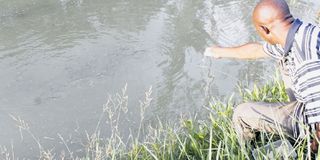Aquaculture harms marine environment

What you need to know:
FISHERIES. Aquaculture has increased the competition for marine space by displacing local fisher people, contributed to aquatic pollution, and adding to the over-exploitation of wild fish stocks which are needed to make the feed used by fish farms
Istanbul. One of the world’s fastest-growing food production industries, aquaculture, is harming the marine environment and people’s lives with intensive fish farms. Fish farming was promoted to contribute to meeting the rising demand for food. But it has brought its own problems.
It has increased the competition for marine space in some cases by displacing local fisher people, contributed to aquatic pollution, and added to the over-exploitation of wild fish stocks which are needed to make the feed used by fish farms. This in turn has worsened social and economic inequality and threatened the quality of and access to marine areas and resources through ongoing expansion in different regions.
The global demand for seafood has steadily risen in the last decades. In 1960s, annual seafood consumption per capita was about 9.9 kilograms per year. In 2016 this rose to 20.3 kg per year.
Industrial capture fisheries have expanded and fish are being caught further from shore, from deeper levels and earlier in the food chain. In addition, fish farming has taken on industrial proportions, with a range of negative knock-on consequences.
In our research, we explored how the growth of fish farming off Turkish waters transformed the way in which seafood production moved from capture to intensive farming. We also show how this led to intensive marine aquaculture becoming more dependent on capture fisheries because fish farms needed fish oil and meals. And lastly, the research highlighted the strategies companies used to further extend and intensify their dominance in marine areas.
Our data illustrated that instead of providing a solution to depleting fish stocks, the intensive marine aquaculture of carnivorous species creates another source of pressure for fisheries, where exploitation leads to further expansion and intensification.
We argue that this continuous expansion is leading to social and ecological crises related to declining stocks and capture fisheries.
We’re calling for a fundamental shift in how the aquaculture industry functions to mitigate its impact on the environment and on communities.
Fish farming expands
Farmed fish production has risen by 8.6 per cent per year in the last three decades and now provides around half the amount of fish that people eat. The share of global aquaculture production in total seafood production, including capture fisheries, increased from 13.4 per cent in 1990 to 46.8 per cent in 2016.
Europe and the US are the largest importers of seafood products, consuming seafood worth billions. The main suppliers are countries in Africa and Asia.
Fish farms were once promoted as a solution for over-fishing. But shrimp and salmon farms in Asia and Latin America have already given rise to ecological, social and political problems.
In the eastern Mediterranean, in Turkey, farmed fish production volume quadrupled between 2000 and 2016. Three quarters of this is exported to the EU to meet urban, middle-class demand.
The farmed fish need to eat too – and what sea bass, sea bream and salmon eat mostly consists of smaller, wild fish.
For these supplies, fishing companies are moving to West African waters, especially Mauritania where they capture small fish to be turned into fish meal and fish oil and eventually fish feed in factories.
The social and ecological costs of this are massive.
Instead of providing a solution to the depletion of fish stocks, the intensive farming of carnivorous fish species thus creates more pressure. The main aim of seafood companies is usually not overcoming social or ecological crises, but protecting their profits. Fish farms are turning marine resources into commodities to be bought and sold.
Where to move from here
Under the current system the biggest seafood companies gain while marine species and small-scale fishers continue to be threatened. There is an urgent need to understand these dynamics and construct an alternative model that will protect the ocean, the rights of small-scale fisher people and ensure the survival of fish species.
The solution lies in the transition to a just and sustainable model of food production, distribution and consumption, which is not controlled by agrobusiness companies but by small-scale producers themselves.
This is also the goal of the social practitioners striving for food sovereignty. In contrast to food security, food sovereignty puts the emphasis on the rights of small-scale food producers and a healthy and ecologically sustainable production. It considers food as a human right rather than a tradable commodity and encourages localised food systems where food producers themselves have control on their production and consumers have the right to know by whom and how the food is produced.
Central to this is building alliances for environmental justice and fisheries justice as realised by the members of the World Forum of Fisher Peoples. (The Conversation)




